![]()
![]()
![]()
Use LEFT and RIGHT arrow keys to navigate between flashcards;
Use UP and DOWN arrow keys to flip the card;
H to show hint;
A reads text to speech;
35 Cards in this Set
- Front
- Back
|
aorta
|
largest arterial structure in the body; arises from the left ventricle to supply blood to the head, upper and lower extremities, and abdominopelvic cavity
|
|
|
celiac axis (CA)
|
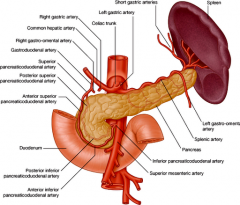
first major anterior artery to arise from the abdominal aorta inferior to the diaphragm; it branches into the hepatic, splenic, and left gastric arteries
|
|
|
common femoral arteries
|
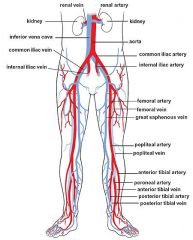
vessels originating from the iliac arteries seen in the inguinal region into the upper thigh
|
|
|
gastroduodenal artery (GDA)
|
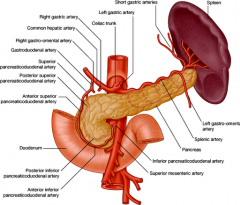
branch of the common hepatic artery that supplies the stomach and duodenum
|
|
|
hepatic artery (HA)
|

common hepatic artery arises from the celiac trunk and courses to the right of the abdomen and branches into the GDA and proper HA
|
|
|
inferior mesenteric artery (IMA)
|
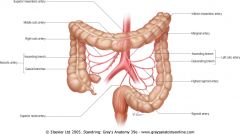
arises from the anterior aortic wall at the level of the third or fourth lumbar vertebra to supply the left transverse colon, descending colon, sigmoid colon, and rectum
|
|
|
left gastric artery (LGA)
|

artery that arises from the celiac axis to supply the stomach and lower third of the esophagus
|
|
|
left renal artery (LRA)
|
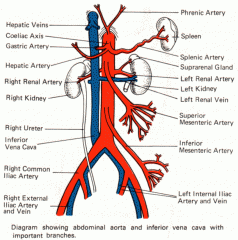
arises from the posterolateral wall of the aorta directly into the hilus of the kidney
|
|
|
right renal artery (RRA)
|

leaves the posterolateral wall of the aorta; travels posterior to the inferior vena cava to enter the hilum of the kidney
|
|
|
splenic artery (SA)
|
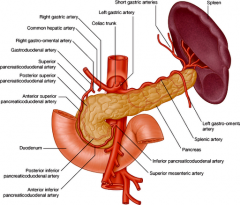
one of the three vessels that arise from the celiac axis to supply the spleen, pancreas, stomach, and greater omentum; forms the superior border of the pancreas
|
|
|
superior mesenteric artery (SMA)
|
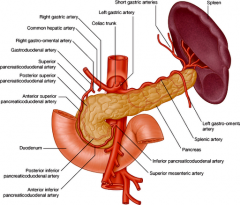
arises inferior to the celiac axis from the anterior wall of the abdominal aorta; travels parallel to the aorta to supply the small bowel, cecum, ascending colon, and transverse colon; lies posterior to the body of the pancreas
|
|
|
collateral vessels
|
ancillary vessels that develop when portal hypertension occurs
|
|
|
confluence of the splenic and portal veins
|

junction of the splenic and portal veins that occurs in the midabdomen and serves as a posterior border of the pancreas
|
|
|
femoral veins
|

upper part of the venous drainage system of the lower extremity found in the upper thigh and groin that empties into the inferior vena cava at the level of the diaphragm
|
|
|
hepatic veins (HV)
|
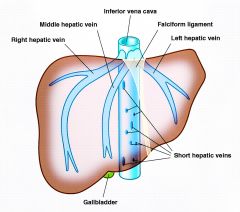
largest tributaries that drain the liver and empty into the inferior vena cava at the level of the diaphragm
|
|
|
iliac veins
|
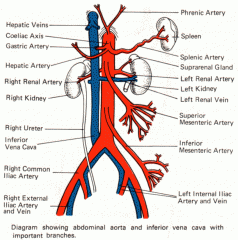
receive tributaries from the lower extremities and drain into the inferior vena cava
|
|
|
inferior vena cava (IVC)
|
largest abdominal vessel formed by the union of the common iliac veins; flows posterior to the liver to enter the right atrium of the heart
|
|
|
left portal vein (LPV)
|
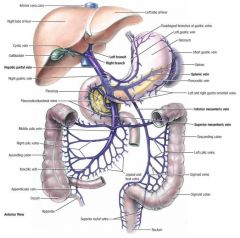
the main portal vein bifurcates into the right and left portal veins; the left portal vein supplies the left lobe of the liver
|
|
|
left renal vein (LRV)
|
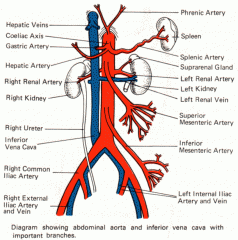
leaves the renal hilum and travels anterior to the aorta, posterior to the superior mesenteric artery, to empty into the lateral wall of the inferior vena cava
|
|
|
main portal vein (MPV) or hepatic portal vein
|
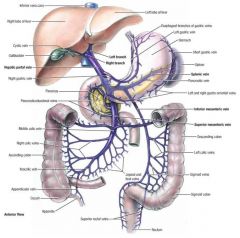
formed by the union of the splenic vein and the superior mesenteric vein; serves as the posterior border of the pancreas; enters the liver at the porta hepatis
|
|
|
portal venous system
|
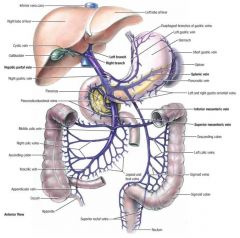
comprises the splenic, inferior mesenteric, superior mesenteric, and portal veins (All bold in photo)
|
|
|
right portal vein (RPV)
|
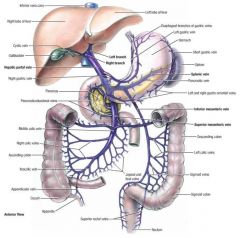
the main portal vein bifurcates into right and left branches; the right portal vein supplies the right lobe of the liver
|
|
|
right renal vein (RRV)
|
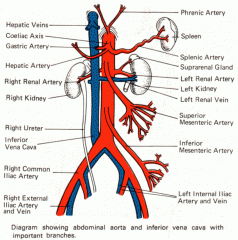
leaves the renal hilum to flow directly into the inferior vena cava
|
|
|
splenic vein (SV)
|
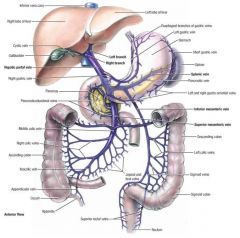
drains the spleen; travels horizontally across the abdomen (posterior to the pancreas) to join the superior mesenteric vein to form the portal vein; serves as the posterior medial border of the pancreas.
|
|
|
superior mesenteric vein (SMV)
|
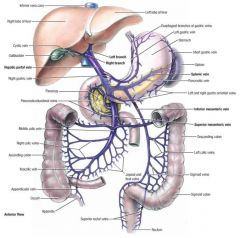
drains the small bowel and cecum, transverse and sigmoid colon; travels vertically to join the splenic and portal veins; serves as a posterior landmark to the body of the pancreas and an anterior border to the uncinate process of the head
|
|
|
caudate lobe
|
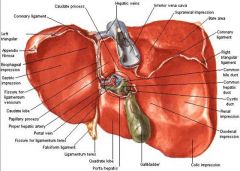
smallest lobe of the liver; lies posterior to the left lobe and anterior to the inferior vena cava; superior border is the ligamentum venosum
|
|
|
crus of the diaphragm
|

muscular structure seen in the upper abdomen at the level of the celiac axis; aligns the vertebral column before crossing the midline posterior to the inferior vena cava and anterior to the aorta; may be mistaken for the right renal artery
|
|
|
dome of liver
|
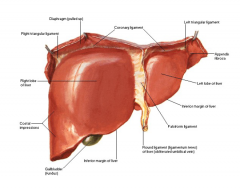
most superior aspect of the liver at the level of the diaphragm
|
|
|
falciform ligament (FL)
|
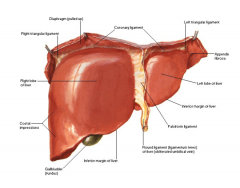
attaches the liver to the anterior abdominal wall and undersurface of the diaphragm
|
|
|
ligamentum teres (LT)
|
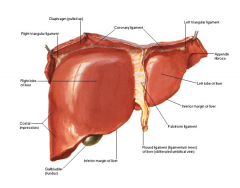
termination of the falciform ligament, seen in the left lobe of the liver
|
|
|
ligamentum venosum (LV)
|
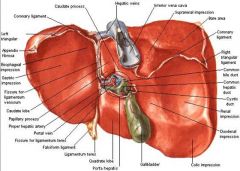
echogenic linear structure found anterior to the caudate lobe and posterior to the left lobe of the liver
|
|
|
Morison’s pouch
|
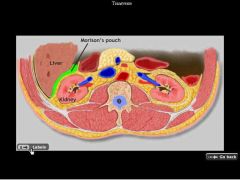
right posterior subhepatic space located anterior to the kidney and inferior to the liver where fluid may accumulate
|
|
|
porta hepatis
|
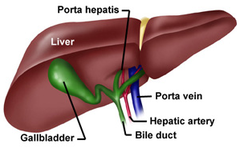
central area of the liver where the portal vein, common duct, and hepatic artery enter; this triad makes the area appear slightly more echogenic
|
|
|
psoas major muscle
|
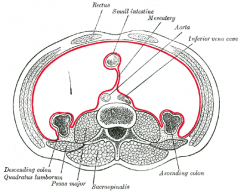
group of muscles that originate at the hilum of the kidneys and lie lateral to the spine
|
|
|
splenic hilum
|
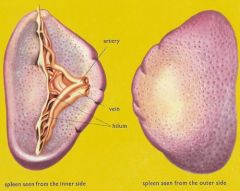
site where vessels and lymph nodes enter and exit the spleen; located in the middle of the spleen
|

